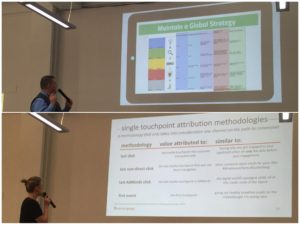Every month Minnesota Search Engine Marketing Association, aka MnSearch, hosts an event dedicated to search marketing. Most recently the event took place on May 25 at Spyder Trap in Minneapolis and the topic of discussion was “Challenging the Assumptions in SEO and SEM.” Industry leaders from PR Caffeine: Home of EspreSEO and Ovative/group led the discussion by challenging search marketing standards and then offered their own approaches to search engine optimization (SEO) and search engine marketing (SEM).
Ryan Berkness, founder and CEO of PR Caffeine: Home of EspreSEO, kicked off the event by sharing his thoughts on search engine optimization with a presentation titled, “Why Google’s Algorithm is (Almost) Irrelevant.” Berkness’ approach to SEO is: “If you build it, they will come.” In other words, if you build quality content then customers will come and in turn, positively affect search engine rankings. Therefore, Berkness’ advice is to concentrate on user experience and relevancy. A user’s experience on your website should meet, if not exceed, their expectations. More specifically, their experience on your website should be organized, easy to navigate and thoughtfully complete. Relevancy boils down to your business plan’s value proposition. Understanding your value proposition and then effectively communicating it helps you create relevancy and thus quality content. As you may have realized user experience, relevancy and SEO are all connected, which is why when the three are used together Google’s algorithm is (almost) irrelevant.
In the second presentation Claire Wyatt, senior analyst of measurement and activation at Ovative/group, delved into the power of SEM. Wyatt began her presentation, called “What’s going on? Understanding the Value of Paid Search Through Multi-Touch Attribution,” by considering the different measurement methodologies available. She explained single touchpoint methods are flawed because their measurement is not representative of the consumer’s path to purchase. More specifically, a consumer’s path to purchase often involves more than one media so it doesn’t make sense to measure singularly. Wyatt’s solution to this measuring error is the multi-touch attribution (MTA) methodology. MTA is a holistic measuring tool offering a breadth of analysis and comparison across all medias rather than just one media. Measurement is generated by a lengthy mathematical procedure, but Wyatt put it into terms for us: “The multi-attribute model compares all medias by spitting out a conversion rate percentage. The values take into account recency, frequency and type of media.” After collecting the data, Wyatt and her team interpret the measurements and make conclusions. The holistic conclusions collected from the MTA method are extremely valuable for making informed strategic decisions and ultimately allocating digital media spending effectively. Ultimately, Wyatt introduced a new perspective to SEM: the best way to measure the value of paid search is through multi-touch attribution.
In an effort to increase search marketing standards and awareness, MnSearch encourages industry leaders like Berkness and Wyatt to share their expertise and insight with other professionals. If you’re interested in attending a MnSearch event get all the details by viewing their event page here.

